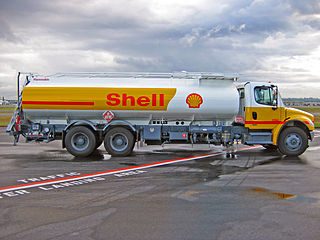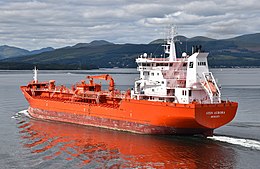A double-hulled tanker refers to an oil tanker which has a double hull. They reduce the likelihood of leaks occurring compared to single-hulled tankers, and their ability to prevent or reduce oil spills led to double hulls being standardized for oil tankers and other types of ships including by the International Convention for the Prevention of Pollution from Ships or MARPOL Convention. After the Exxon Valdez oil spill disaster in Alaska in 1989, the US government required all new oil tankers built for use between US ports to be equipped with a full double hull.

The International Convention for the Prevention of Pollution from Ships, 1973 as modified by the Protocol of 1978, or "MARPOL 73/78" is one of the most important international marine environmental conventions. It was developed by the International Maritime Organization with an objective to minimize pollution of the oceans and seas, including dumping, oil and air pollution.

A cargo ship or freighter is a merchant ship that carries cargo, goods, and materials from one port to another. Thousands of cargo carriers ply the world's seas and oceans each year, handling the bulk of international trade. Cargo ships are usually specially designed for the task, often being equipped with cranes and other mechanisms to load and unload, and come in all sizes. Today, they are almost always built of welded steel, and with some exceptions generally have a life expectancy of 25 to 30 years before being scrapped.

A merchant ship, merchant vessel, trading vessel, or merchantman is a watercraft that transports cargo or carries passengers for hire. This is in contrast to pleasure craft, which are used for personal recreation, and naval ships, which are used for military purposes.

A tank car or tanker is a type of railroad car or rolling stock designed to transport liquid and gaseous commodities.

A bulk carrier or bulker is a merchant ship specially designed to transport unpackaged bulk cargo—such as grain, coal, ore, steel coils, and cement—in its cargo holds. Since the first specialized bulk carrier was built in 1852, economic forces have led to increased size and sophistication of these ships. Today's bulk carriers are specially designed to maximize capacity, safety, efficiency, and durability.

A tanker is a ship designed to transport or store liquids or gases in bulk. Major types of tankship include the oil tanker, the chemical tanker, cargo ships, and a gas carrier. Tankers also carry commodities such as vegetable oils, molasses and wine. In the United States Navy and Military Sealift Command, a tanker used to refuel other ships is called an oiler but many other navies use the terms tanker and replenishment tanker. Tankers were first developed in the late 19th century as iron and steel hulls and pumping systems were developed. As of 2005, there were just over 4,000 tankers and supertankers 10,000 LT DWT or greater operating worldwide.

A tank truck, gas truck, fuel truck, or tanker truck or tanker is a motor vehicle designed to carry liquids or gases on roads. The largest such vehicles are similar to railroad tank cars, which are also designed to carry liquid loads. Many variants exist due to the wide variety of liquids that can be transported. Tank trucks tend to be large; they may be insulated or non-insulated; pressurized or non-pressurized; and designed for single or multiple loads. Some are semi-trailer trucks. They are difficult to drive and highly susceptible to rollover due to their high center of gravity, and potentially the free surface effect of liquids sloshing in a partially filled tank.

Intermediate bulk containers are industrial-grade containers engineered for the mass handling, transport, and storage of liquids, semi-solids, pastes, or solids. The two main categories of IBC tanks are flexible IBCs and rigid IBCs. Many IBCs are reused or repurposed.

An oil terminal is an industrial facility for the storage of oil, petroleum and petrochemical products, and from which these products are transported to end users or other storage facilities. An oil terminal typically has a variety of above or below ground tankage; facilities for inter-tank transfer; pumping facilities; loading gantries for filling road tankers or barges; ship loading/unloading equipment at marine terminals; and pipeline connections.

An LNG carrier is a tank ship designed for transporting liquefied natural gas (LNG).

An oil tanker, also known as a petroleum tanker, is a ship designed for the bulk transport of oil or its products. There are two basic types of oil tankers: crude tankers and product tankers. Crude tankers move large quantities of unrefined crude oil from its point of extraction to refineries. Product tankers, generally much smaller, are designed to move refined products from refineries to points near consuming markets.

A tank container or tanktainer is an intermodal container for the transport of liquids, gases and powders as bulk cargo. It is built to the ISO standards, making it suitable for different modes of transportation; as such, it is also called an ISO tank. Both hazardous and non-hazardous products can be transported in tank containers.
Oil tankers generally have from 8 to 12 tanks. Each tank is split into two or three independent compartments by fore-and-aft bulkheads. The tanks are numbered with tank one being the forwardmost. Individual compartments are referred to by the tank number and the athwartships position, such as "one port", "three starboard", or "six center."

CargoMax is a stability and load management software application for marine and offshore industries. It is developed and sold by Herbert-ABS Software Solutions, LLC. First released in 1979, CargoMax was one of the first computerized systems for planning and evaluating ship loading; it is currently one of the most-used software applications for this purpose. It helps determine cargo loading sequences by calculating stability and stress based on ship models created from vessel data: lightship weights, hydrostatic characteristics, tank data, and allowable shear forces and bending moments. Naval architects and engineers from Herbert-ABS customize each CargoMax installation using shipyard drawings and technical data. Different installations also include different sets of features from the program.
The MACS3 Loading Computer System is a computer controlled loading system for commercial vessels, developed by Navis Carrier & Vessel Solutions. Prior to October, 2017 it was offered by Interschalt maritime systems GmbH, and before 2007 - by Seacos Computersysteme & Software GmbH.
A shipping container is a container with strength suitable to withstand shipment, storage, and handling. Shipping containers range from large reusable steel boxes used for intermodal shipments to the ubiquitous corrugated boxes. In the context of international shipping trade, "container" or "shipping container" is virtually synonymous with "intermodal freight container", a container designed to be moved from one mode of transport to another without unloading and reloading.
All cargo vessels where MARPOL Convention is applicable must have an oil record book in which the officer responsible will record all oil or sludge transfers and discharges within the vessel. This is necessary for authorities to be able to monitor if a vessel's crew has properly disposed of their oil discharges at sea.

A gas carrier, gas tanker, LPG carrier, or LPG tanker is a ship designed to transport LPG, LNG, CNG, or liquefied chemical gases in bulk.

The HNS Convention is an international convention created in 1996 to compensate for damages caused by spillage of hazardous and noxious substances during maritime transportation. The convention is officially known as the International Convention on Liability and Compensation for Damage in Connection with the Carriage of Hazardous and Noxious Substances by Sea, 1996. The convention has not entered into force due to signatory states not meeting the ratification requirements. Canada, France, Germany, Greece, the Netherlands, Norway, and Turkey signed the 2010 protocol to the convention.
















